Portrait of the Artist: Ford Crull
“Portrait of the Artist” is a series by photographer Claudine Williams. The Q&As are with people in the arts and culture industry — actors, musicians, painters, writers, designers — with photos to suit each artist.
Ford Crull has been working and living and painting — large abstracts that riff on classic iconography — in his Tribeca studio since the mid-80s.
Describe what you do for a living and how did you get started in that business?
I graduated in graphic design and fine arts and was doing both of them for a number of years. I was a creative director at Gray Advertising and was doing my art at the same time. In the ‘80s, I came out of the East Village art scene and was doing quite well there, so it made the creative director job really difficult. There was a period where I was just never sleeping. I had five one-man shows back to back — I don’t know how anyone could do that now. I was doing that while I had a full time job at Grey. It was really a handful.
Eventually in the ’90s I started my own design company doing mostly real estate websites. And the painting just seemed to slowly take over. I will still do some design projects now and then. I was always a full-time painter, but I had less and less interest in design and I was really quite busy with galleries.
Where did you grow up and how did you wind up in Lower Manhattan?
I’ve been in Tribeca for 35 years. In about ’84 or ’85, I was looking for a nice loft space to paint and live, and basically this was no-mans land. I liked it because it was so close to the water. Growing up in Seattle, I was so used to the lake that I felt more comfortable and less claustrophobic here. I looked in Brooklyn and uptown, but down here it was very quiet and just felt right.
What kinds of projects are occupying your time right now?
I call my work neo-symbolic abstraction. That whole idea of symbolism of the late 19th Century – Chauvin, Redon, James Ensor – they were the first artists to juxtapose images with multiple meanings in their work. What I was really drawn to is the work had very ambiguous meanings. One thing they said that was truthful to me is that nothing that the artist intended in the work has any more validity than what the viewer sees in it. The work is ambiguous on purpose. I’m always looking for something that is more unconscious.
I make up a lot of my own symbols, icons and pictograms. Throughout history they have been such a factor within civilizations. Symbols can be so vital in implementing political views. And there can be such a double meaning depending on the culture and the time frame. More recently I have been still creating my own hieroglyphics and icons and pictograms, but in such a loosely painted format that sometimes you’ll see hearts and eyes and crosses – it’s kind of a hybrid.
I always think my painting is my painting but I realized after I travelled to Brazil that the environment had affected me quite intensely. The canvases became very white with areas of intense color. I didn’t notice it at first, but then I realized how different my work was up until that point. The same thing happened when I went to Thailand – I started doing paintings with a lot of washed oil. The work became much more colorful and alive and the paintings became much more beautiful – much more lyrical. They flowed over the whole surface.
What is the most satisfying part of your work?
The way the colors and the forms and the symbols are interwoven in terms of a whole. There’s this kind of infinite space that they can look like they are part of in front or a part of in back – there’s a lot of interweaving in my work.
What is the perfect downtown weekend?
Until recently we would go to the Odeon and then to the Reade Street Pub for a glass of wine or something. Like a lot of restaurants, they had crayons on the table and I would get intensely involved into those crayon drawings and then I’d rip them out of the paper tablecloth and take them home. It was conducive to working. In the summer you can find me in Rockefeller Park reading or drawing.
What’s the best thing about living in Lower Manhattan?
The hum and roar of the city is less predominant down here – it is more conducive to working. But when I first moved here, it was also a great time. One of the things that is kind of strange is places were open much later then as opposed to now. The Odeon was open till 4. Blue Ribbon was open till 4. Another popular place, 211, was open till 4 – even with fewer people around, the bars and restaurants were going all night long.
I was lucky enough to have bought my space in ’87 so I am able to live here but it certainly has become tres chere. The thing is now, you sell your place for a lot of money but where you going to go? In spite of the fact it’s become so expensive it’s really home to me. It’s where I most want to be.








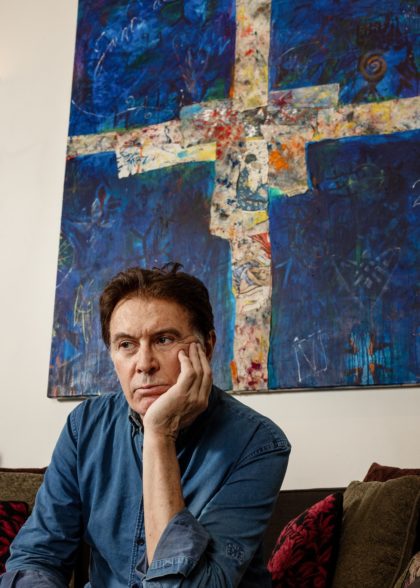
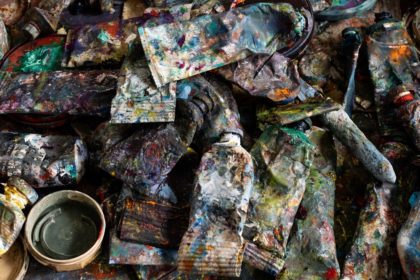
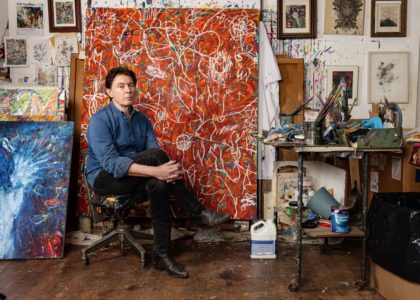
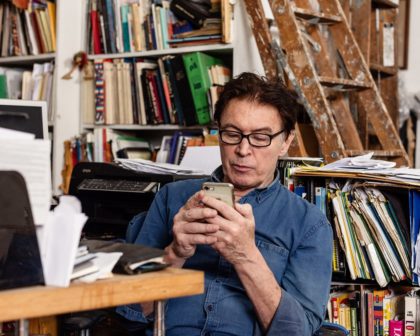
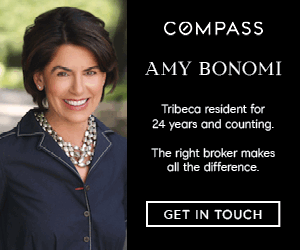










Atta boy, Ford!
You are a Tribeca trailblazer and icon!
I’ve known Ford and his work for some time. I have always been impressed by his practice and scope. A prolific artist with many unique visual sources.
Thanks for this piece on Ford. There are not that many artists left in the neighborhood. I am grateful to have one of his small drawings hanging on my wall.
Ford, I’m so glad for the time I could spend in your studio surrounded by all the color and symbols and your love!
You’ve taught and given me so much and this article helped me realize that more.
Thank you for Blessing my life,
Derek
Ford is fantastic! I am a fan of this work!
Ford, what a great piece! So good to read. I too am a fan.
You are the Renaissance man.
Ford, I am never tired of seeing your work. The colors, symbols and messages within each piece always amaze. Your fan!